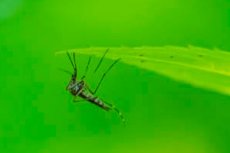New publications
Genetic modification prevents mosquitoes from spreading malaria
Last reviewed: 27.07.2025

All iLive content is medically reviewed or fact checked to ensure as much factual accuracy as possible.
We have strict sourcing guidelines and only link to reputable media sites, academic research institutions and, whenever possible, medically peer reviewed studies. Note that the numbers in parentheses ([1], [2], etc.) are clickable links to these studies.
If you feel that any of our content is inaccurate, out-of-date, or otherwise questionable, please select it and press Ctrl + Enter.

Mosquitoes kill more people each year than any other animal. In 2023, the blood-sucking insects infected an estimated 263 million people with malaria, leading to nearly 600,000 deaths, 80% of whom were children.
Recent efforts to stop malaria transmission have stalled as mosquitoes have developed resistance to insecticides and the parasites that cause malaria have become resistant to drugs. These setbacks have been compounded by the COVID-19 pandemic, which has complicated ongoing malaria control efforts.
Now, researchers from the University of California, San Diego, Johns Hopkins University, UC Berkeley and the University of Sao Paulo have developed a new method that genetically blocks mosquitoes' ability to transmit malaria.
Biologists Zhiqian Li and Ethan Beer of UC San Diego, and Yuemei Dong and George Dimopoulos of Johns Hopkins University have created a CRISPR-based gene-editing system that alters a single molecule in a mosquito’s body — a tiny but effective change that stops the transmission of the malaria parasite. The genetically modified mosquitoes can still bite infected people and pick up the parasite from their blood, but they can no longer transmit it to other people. The new system is designed to genetically spread the malaria-resistance trait until entire populations of these insects no longer carry the parasite.
“Changing one amino acid in a mosquito to another naturally occurring one that interferes with infection by the malaria parasite — and spreading that beneficial mutation throughout the mosquito population — is a real breakthrough,” said Bier, a professor in the department of cell and developmental biology in the UC San Diego School of Biological Sciences. “It’s hard to believe that such a small change could have such a dramatic effect.”
The new system uses CRISPR-Cas9 as “genetic scissors” and guide RNA to make a cut in a precise region of the mosquito genome. It then replaces an unwanted amino acid that facilitates malaria transmission with a beneficial one that interferes with the process.
The system targets a gene that codes for a protein known as FREP1. This protein helps mosquitoes develop and feed on blood when they bite. The new system replaces the amino acid L224 in FREP1 with a different allele, Q224. The parasites use L224 to get to the insect's salivary glands, where they prepare to infect a new host.
Dimopoulos, a professor in the Department of Molecular Microbiology and Immunology and a member of the Johns Hopkins Bloomberg School of Public Health’s Malaria Research Institute, and his lab tested strains of Anopheles stephensi mosquitoes, the main vector of malaria in Asia. They found that replacing L224 with Q224 effectively blocked two different types of malaria parasites from entering the salivary glands, thereby preventing infection.
“The beauty of this approach is that we use a naturally occurring allele of a mosquito gene. With one precise change, we turn it into a powerful shield that blocks multiple species of malaria parasite — and likely in different mosquito populations and species. This opens the door to adaptable, real-world disease control strategies,”
said George Dimopoulos.
In subsequent tests, the researchers found that while the genetic change prevented the parasite from infecting the body, the mosquitoes’ growth and reproduction were unaffected. Mosquitoes with the new version of Q224 were as viable as mosquitoes with the original L224 amino acid—an important achievement, given that the FREP1 protein plays an important role in mosquito biology, independent of its role in transmitting malaria.
Similar to the “gene drive” system, the researchers developed a method that allows mosquito offspring to inherit the Q224 allele and spread it throughout the population, thereby stopping the transmission of malaria parasites. This new “allelic drive” system follows a similar system recently developed in Beer’s lab that genetically reverses insecticide resistance in agricultural pests.
“In that previous study, we created a self-terminating drive that reverts a fruit fly population from insecticide resistance back to susceptibility. Then that genetic cassette element simply disappears, leaving only a ‘feral’ population,” Bier explained. “A similar ghost system could convert mosquito populations to carry the parasite-resistant FREP1Q variant.”
Although the researchers have shown that replacing L224 with Q224 is effective, they do not yet fully understand why this change works so effectively. Further studies are underway to determine exactly how the amino acid Q224 blocks the parasite's route of entry.
“This breakthrough is the result of impeccable teamwork and innovation across scientific institutions,” added Dimopoulos. “Together, we used nature’s own genetic tools to turn mosquitoes into allies in the fight against malaria.”
The study was published in the journal Nature.
